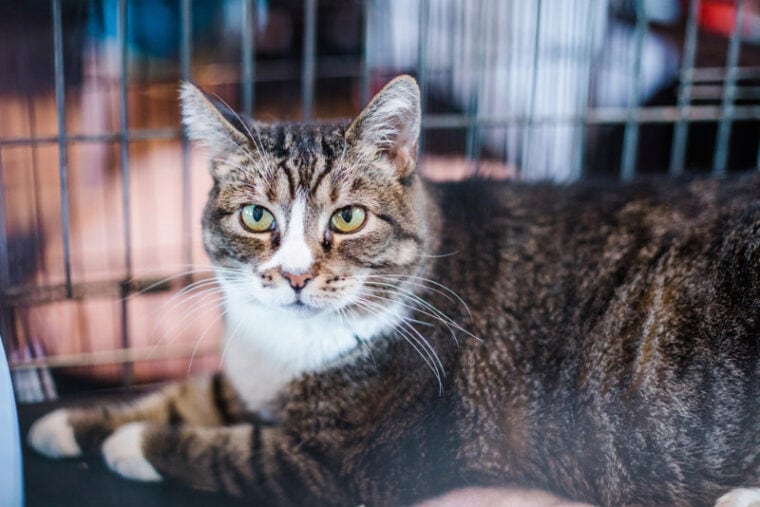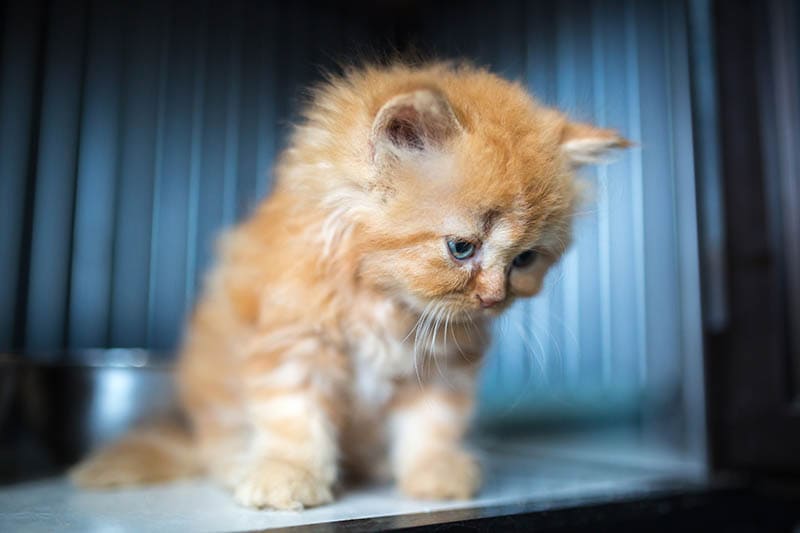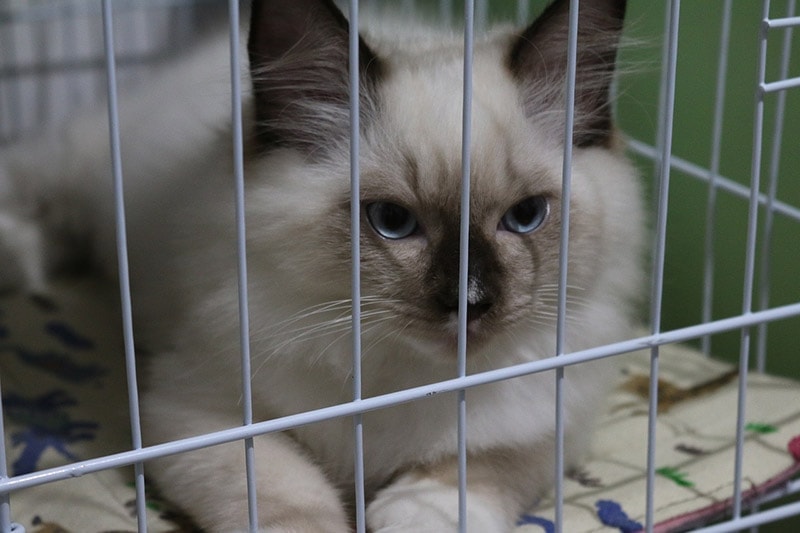
If you’re a cat owner, you may wonder how long your furry friend can stay in a crate. The answer depends on several factors, including age, health, temperament, crate size, and temperature. Cats are independent by nature, and most cats may have difficulty being confined to a crate unless they have been appropriately crate-trained. Meanwhile, others may feel safe and secure and may choose to rest and sleep in their crate. Generally, you don’t want to keep your crate-trained cat in their crate for more than 4 to 6 hours. Here are some frequently asked questions you may have about cat crate time.
What Is the Maximum Amount of Time a Cat Can Stay in Their Crate?
Cats can generally stay in their crate for 4 to 6 hours per day as long as they have ample space to move around and access food, water, and a litter box. Prolonged periods of time in a crate can cause discomfort and stress, leading to anxiety and health issues.
What Factors Influence How Long a Cat Can Stay in Their Crate?
Cats are generally independent animals that enjoy exploring their environment, so confining them to a crate for extended periods is not recommended. However, crating is necessary in some situations, such as during illness or recovery after surgery, travel, training a kitten, or introducing new pets. The duration an appropriately crate-trained cat can comfortably stay in a crate depends on various factors, including age, health, temperament, crate size, and temperature.
Age
Kittens and elderly cats may require more frequent breaks from their crate due to their specific needs. Kittens tend to be more energetic and curious, so they may become restless if confined for too long. Elderly cats may have mobility issues or medical conditions that require more frequent monitoring and attention.
Health
A cat’s overall health plays a significant role in determining how long they can stay in their crate. Cats with medical conditions, such as bladder issues, arthritis, or anxiety, may need more frequent breaks or shorter periods of confinement to ensure their well-being.
Temperament
Some cats are more adaptable to being in a crate, while others may become stressed or agitated. Assess your cat’s personality and consider their individual preferences when determining the appropriate duration for crate confinement.

Crate Size
The size of the crate can significantly impact how long a cat can comfortably stay inside. A larger crate that allows the cat to stand, stretch, and turn around will be more comfortable for longer periods than a smaller, restrictive crate. It has to be big enough to allow for food and water bowls, a litter box, toys, and a smaller scratch post.
Temperature
The temperature within the crate should be considered when determining how long a cat can stay inside. Ensure the crate is well-ventilated and placed in an area with a stable temperature, avoiding direct sunlight or drafts. Overheating or excessive cold can cause discomfort and stress for your cat, not to mention that it may endanger their health, so monitoring the temperature is crucial.
Enrichment and Comfort
Providing your cat with familiar items, such as a soft bed or blanket and a favorite toy, can make their time in the crate more comfortable. Including these items can help reduce stress and make it easier for your cat to tolerate longer periods in the crate.
Frequency of Breaks
Your cat needs plenty of physical and mental stimulation each day, and too much crate time will lead to unhappiness and frustration. It’s essential to provide your cat with regular breaks from the crate, allowing them to stretch, use another litter box, eat, drink, and interact with you. The frequency of these breaks will depend on your cat’s age, health, and individual needs.
In general, it’s best to minimize the amount of time a cat spends confined to a crate. However, by considering these factors and adjusting the duration accordingly, you can ensure your cat’s comfort and well-being while they are crated.
When Is It Appropriate to Leave Your Cat in a Crate?
Using a crate for your cat can be beneficial in specific situations, but it’s crucial not to rely on it as a long-term solution for confinement. Cats are social and curious animals that need mental stimulation, physical activity, and interaction with their environment and owners.
Cats can occasionally be confined to a crate, but only if they have been appropriately crate-trained using positive reinforcement so they can feel safe and comfortable in their crate and not see it as punishment.

Here are some appropriate scenarios for using a crate with your cat:
Travel
Crates are essential for ensuring your cat’s safety and comfort during travel, whether by car or airplane. A crate provides a secure, familiar space for your cat, reducing stress and anxiety during the journey.
Veterinary Stay
Crate training can be useful when your cat needs to stay at the vet for a particular treatment or surgery, especially for a few days or longer. During their stay at the vet’s clinic, the kennels resemble a crate your cat may have used at home. They are adapted to a veterinary clinic setup but are usually designed to keep your cat comfortable inside, with a hide box and a soft bed. These kennels are often heated as well to keep them cozy and warm, feeling safe, and with access to their food, water bowl, and litter box. At the same time, these kennels provide your vet with visual access so they can check on them frequently and quickly pick up any problems. It protects them from potential hazards and prevents them from escaping into an unfamiliar environment.
House Training New Kittens
Using a crate for short periods can be helpful when introducing a new kitten to your home. It can provide a safe, controlled space for the kitten to adjust to their new surroundings, well out of reach of potential hazards when you’re not at home, and may be used for litter box training.

Introducing New Pets
If you’re bringing a new pet into your home, a crate can be useful for gradually introducing your cat to the newcomer. This controlled environment allows both animals to become familiar with each other’s scents and presence while minimizing the risk of conflict.
Home Renovations or Emergencies
During home renovations, moving, or emergencies, a crate can provide a safe and secure place for your cat, protecting them from potential dangers and reducing their stress.
Recovering from Illness or Injury
If your cat is recovering from an illness, surgery or injury, a crate can provide a quiet and safe space for rest. Using the crate during these times can help reduce stress levels, allowing them to heal more quickly.
How Do You Choose the Right Size Crate for Your Cat?

Selecting the appropriate crate size for your cat is essential for their comfort and well-being. A properly sized crate will give your cat enough space to move around, stretch, and feel secure.
Here are some guidelines and tips on choosing the right size crate for your cat:
Measure Your Cat
To determine the correct crate size, measure your cat’s length from the tip of their nose to the base of their tail. Additionally, measure their height from the floor to the top of their head while they are standing. These measurements will help you find a crate that provides ample space for your cat.
Crate Length
The crate should be long enough to allow them to stretch out comfortably without feeling cramped and to accommodate a small litter box, food and water dishes, and a comfortable bed, making it more suitable for longer periods of confinement.
Crate Height
Ensure the crate is tall enough for your cat to stand up fully without touching the ceiling. This allows your cat to move around and change positions easily, which contributes to their overall comfort.
Crate Width
The width of the crate should allow your cat to turn around with ease. This ensures they can easily change their position and access different areas within the crate, such as the litter box or food and water dishes.

Ventilation and Visibility
Choose a crate with adequate ventilation and visibility, but enough room for a nice comfy bed or even a little house or box, as this helps your cat feel more secure and comfortable. Crates with wire mesh sides or large openings provide good airflow and allow your cat to see their surroundings, reducing potential stress and anxiety. But remember that the mesh should still be small enough to avoid your cat trying to get their paws or nails through, as this may cause them injury. Cats like to look at the world around them from above, so a little house with a perch or a DIY solution may help them feel comfortable and at the same time give them a space to hide in when they feel like it.
Door Accessibility
Make sure the crate has an easy-to-open door that securely latches shut. This ensures that your cat can be safely contained while also allowing you to easily access them when needed.
Quality and Durability
Select a crate made from high-quality, durable materials that can withstand your cat’s movements and potential attempts to escape. A sturdy crate will provide a safe and secure environment for your cat during confinement.
Tips for Making Crate Time a Pleasant Experience for Your Cat

Crate time should never be stressful for your cat or feel like a punishment. It is something that needs to be learned gradually over time, and still, not all cats will accept it, which is fine. Your cat may not want to be crated, and you shouldn’t force it, as it may cause them significant distress. Cats that are properly trained to use the crate will see it as a safe and enjoyable space where only good things happen and will choose to use it themselves. Here are some tips for making it a good experience:
Create a Comfortable Environment
Place a soft blanket or towel in the crate and make sure that all of their necessities, such as food and water dishes, litter box, toys, and bedding, are easily accessible. This can help them feel more secure and comfortable in their crate. A crate can be a place where they get their meals and treats, and they should choose to enter on their own with the open door as much as possible.
Provide Mental Stimulation
Offering your cat toys or activities, such as scratching posts or treat puzzles, can help keep them occupied and reduce boredom during confinement.
Be Patient
Allow your cat time to adjust to the crate, gradually increasing the confinement duration. This helps reduce stress levels and can help your cat become more comfortable with the crate.
Reward Positive Behavior
Rewarding positive behavior, such as entering the crate willingly or staying calm while in the crate, with treats or praise can help make crate time a pleasant experience for your cat. If you are not sure how to train your cat to use the crate in a stress-free manner, speak to your vet or a feline behaviorist.
Conclusion
Crates can be a useful tool for providing a safe and secure environment for your cat during specific situations. However, it’s important to remember that cats are social animals that need mental stimulation, physical activity, and interaction with their environment and owners. It’s important to keep the time inside a crate limited to only what’s necessary in the best interest of your cat’s health and safety.
Featured Image Credit: Cavan-Images, Shutterstock








